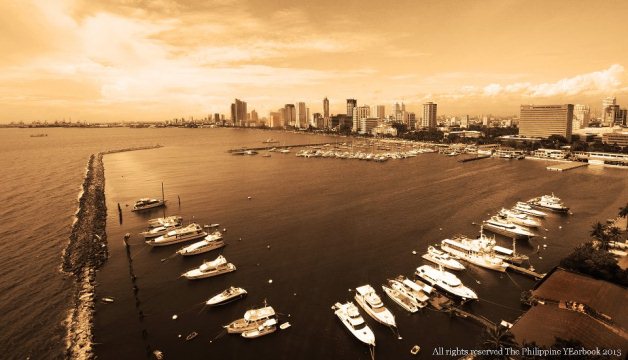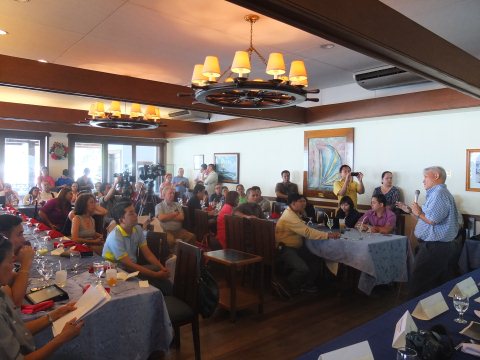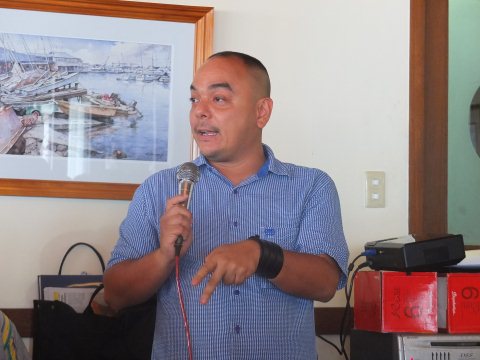SUMMARY
This is AI generated summarization, which may have errors. For context, always refer to the full article.
MANILA, Philippines – Manila Bay is under threat again.
Twenty-one years after protesters got the Manila City Council to prohibit reclamations on Manila Bay, the council reversed its decision and permitted a developer to begin reclamation.
Now, Gold Coast needs only a Notice to Proceed to begin reclamation, a project that will obliterate the entire Manila Bay park, famous for its unique sunset view, and replace it with an “entertainment city.”
The “Manila Gold Coast Corporation,” the developer behind the reclamation, is the same one behind the scrapped 1992 project. In February 2011, it persuaded the city council to reverse the ordinance banning reclamation.
In April 2012, a consortium agreement was signed to reclaim 148 hectares of the waterfront, stretching from the Cultural Center of the Philippines to the US embassy. This size is 10 times that of Rockwell Power Plant Mall and twice Rizal Park.
No public consultation
The same protesters of 1992 are once again in arms, calling the Manila City Council to revoke the permission given to Gold Coast and to bring back the ordinance banning reclamation projects once and for all.
One major grievance sited by protesters is that the City Council failed to engage residents of Manila before signing a contract with Gold Coast.
In a press conference at the Manila Yacht Club on January 5, urban planners, environmentalists, heritage advocates and Manila residents presented to the press their reasons for opposing the reclamation project.
Lawyer Galahad Pe Benito, tasked to explain the legal aspect of the issue, said, “There was no public bidding for this project. When we asked to see the contract with Gold Coast, the Government Corporate Council and PRA (Philippine Reclamation Authority) said, “It is privileged. We cannot show it to you.”
The primary problem posed by the reclamation, according to them, is environmental.
More flooding
Lory Tan, chief executive officer of World Wildlife Fund (WWF) Philippines, said, “Reclamation is a risky technology for Manila because of rising sea levels and increased rainfall. The Philippines has one of the highest sea level rises in the world. Reclamation will only aggravate it.”
According to the WFF head who himself grew up in Manila, the reclamation will exacerbate the already uncontrollable problem of flooding in the area.
Based on studies conducted by WWF, a poorly planned reclamation will create a giant bowl between Manila and the seashore. The natural slope of Manila Bay helps drain rain water. Once reclamation is completed, the slope will be replaced by higher ground and the rain water will have nowhere to go, thereby creating a new flood area.
Though the Mines and Geosciences Bureau has conducted a study of the reclamation plan, Tan and the other environmentalists present at the press conference are not satisfied.
He declared, “Clearly, the study done for this plan does not capture the full breadth of scientific inquiry required. The plan goes against the grain of this administration.”
Protect the commons
President Ramon Magsaysay declared Manila Bay a public park in 1954. In 1992, Republic Act 7586 included Manila Bay it in the National Integrated Protected Areas System Act intending it to be a park for the people.
Where have our parks and public places gone?
Manila Bay remains the only free space in Manila where one can enjoy a beautiful sunset without paying a cent. Speakers at the press conference believe that once the “entertainment city” is constructed, admission to it will be restricted to those who can afford the “city’s” establishments.
Father John Leydon, Malate’s parish priest for 30 years, grieves, “This reclamation is a privatization of the commons. Manila belongs to everyone. Financially, [the project] makes a lot of sense but economic activity has to be for the common good.”
Nora Juat, speaking as a representative of Manila’s urban poor, fumed, “Hindi nalulutas ang problema ng informal settlers. Magkakaroon na naman ng matinding baha. Babalik sa amin ‘yung tubig at basura (The problem of informal settlers will not be solved. Intense flooding will happen again. The flood water and trash will just get washed to us).”
Waterfront of our history
Aside from being a public park, Manila Bay is a historical landmark unique to the world. No other Asian country can boast of so long a waterfront or one that has figured so prominently in a country’s history.
Ivan Henares of the Heritage Conservation Society says, “It was here that the rajas fought the Spanish. It witnessed the British invasion and McCarthur’s return…It is a waterfront of our history and is one of the last few tourist destinations we can be proud of.”
For urban designer Paolo Alcazaren, the reclamation means a destruction of a unique city landscape. Roxas Boulevard, formerly Dewey Boulevard, is all that remains of legendary urban planner Daniel Burnham’s master plan for Manila. Burnham also famously designed Chicago and its world-renowned Lakeshore Drive took its template from Dewey Boulevard.
After the reclamation, Alcazaren laments, “Roxas Boulevard will just be another Taft Avenue.”
For many Manila residents, the destruction of Manila Bay is a stain on their personal and collective memories of the city.
Manila resident and tour guide Ivan Man Dy says, “It’s very personal for me. I’ve lived here all my life. You will take out the sea from the city. Manila Bay is already part of my system.”
Former Miss Universe, President of Ballet Philippines and Manila resident Margie Moran also disapproves of the reclamation: “It’s not going to benefit the people of Manila. It’s not the only thing the city can build on. Instead of reclamation, they should just redevelop the areas in Manila that are decaying.”

Beyond money
The issue is heating up because of the upcoming elections. Talk in the press conference soon shifted to the two candidates for Manila mayor and what stand each will take on reclamation.
Doris Magsaysay Ho, President of Magsaysay Inc and Magsaysay Maritime Corporation, said she hopes they remember that money is not everything.
“There is nothing wrong with self-interest but it should be enlightened. Cultural upliftment, spiritual morale and the pride a citizen feels has a value beyond money.”
And before anyone gets excited about how many jobs a giant entertainment city will generate, Lory Tan asked, “But how many existing jobs and livelihoods will the reclamation destroy? The money will go to a few. It won’t trickle down to the people. There are other better options for economic growth.”
The protestors call on citizens to sign their online petition to scrap the Gold Coast reclamation project. You can sign the petition here. – Rappler.com
Add a comment
How does this make you feel?










There are no comments yet. Add your comment to start the conversation.